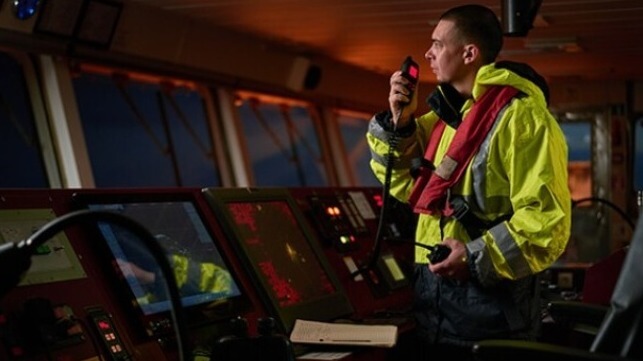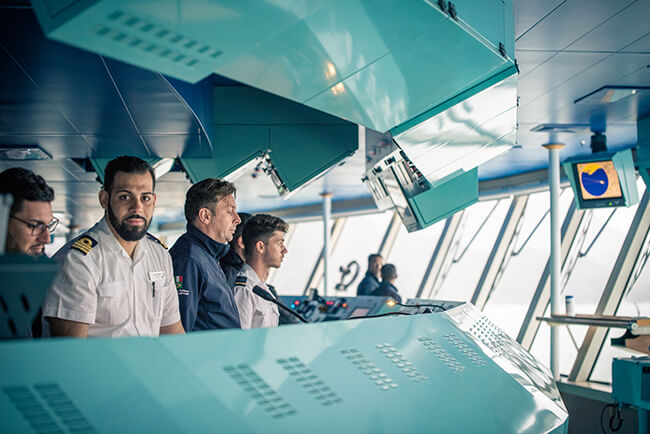The Importance of Ship-to-Shore Communication Is More Vital Than Ever

In today’s inter-connected world, it is easy to take for granted that ship crews can stay in touch with their shoreside offices at all times. Gone are the days of hoping that there would be a telex connection to pass information back and forth. Being instantly connected via high-speed internet means the Master’s responsibilities are today closely integrated with the shoreside office. But just as it has become relatively easy to share information, so too is it more necessary than ever that the information be shared between all stakeholders.
The reasons for this are many. The value of ship to shore communication systems can be listed under various headings, including safety, efficiency, risk abatement, and the ever-tightening regulatory environment. Let’s take these one-by-one.
Safety: The world’s merchant fleet is growing in size all the time. In terms of deadweight tonnage, the global fleet has doubled in size since 2005 and despite the growth slowing in recent years, it has nevertheless still increased by three percent since 2019. At the end of 2020, there were approximately 62,100 vessels sailing the world’s oceans.
The chances of collisions at sea, and especially when maneuvering in port, have therefore never been greater. At the same time, ships have to contend with often hazardous weather conditions and sail in dangerous regions, such as war zones or locations where piracy can occur. These are all safety issues.
The need for shoreside tams to seamlessly track their vessels and crews, and to communicate with each other on existing and anticipated dangerous situations has become increasingly important. And in accidents at sea situations, integrating vessel tracking into crisis room operations has undoubtedly saved lives.
Efficiency: The effective control of operating costs has never been as relevant as it is in today’s competitive market. Optimizing routes and conserving fuel to the maximum extent is essential to any shipping company’s bottom line performance. This requires close coordination between ship and shore, and the use of the latest and most advanced digital tools.
The noon report is a prime example of the detail that shoreside staff need from their ships throughout a voyage. This report is a data sheet prepared by the ship’s chief engineer on a daily basis. It informs the company of the vessel’s position and a host of other relevant standardized data to assess the performance of the ship. The noon report is also used by ship managers to assess and compare the operational performance of ships within the same fleet. It is also used to include information needed to satisfy charter party agreements.
Risk abatement: Mitigating risk is necessary for all businesses, shipping companies included, in order to prepare for and lessen the effects of threats and potentially serious interruptions to the continuity of the business. Improved communication and tracking capabilities provide the shoreside office with deeper insights into everything that is happening regarding vessel operations. Having this information clearly increases the ability to prepare an effective risk management strategy.

Digital technology now available reduces the reliance on traditional communication methods, such as long email chains, where important information can easily be missed. Instant access to relevant data is a key enabler for effective risk abatement.
Another important aspect of risk mitigation is the recent UK Supreme Court decision on the case of the CMA CGM Libra. This has changed the landscape dramatically. Ship owners are now obligated to carry out due diligence on passage plans before, or at the commencement of a voyage, to assure the vessel’s sea-worthiness. Without this being done, the company may be jeopardizing its ability to apply the Hague-Visby rules in declaring General Average. The Hague-Visby rules relate to bills of lading. Depending on the circumstances, the rules allocate, restrict or exclude liability of the carrier and ship.
The ever-tightening regulatory environment: Shipping companies are today faced with a plethora of rules and regulations for which compliance is essential. The IMO’s efforts to curb the carbon intensity of shipping have led to new regulations and restrictions, while existing ones have become more and more stringent. Added to these are the many rules and regulations imposed by regional and local authorities.
Staying abreast of this legislative minefield is a daunting task, and ship leaders need to be well informed throughout a voyage of the environmental compliance requirements they need to be aware of. Again, communication is essential in ensuring that the ship remains compliant at all locations throughout its voyage.
Managing the fleet
Fleet managers require the ability to closely monitor the company’s ships at all times. Situational awareness is central to efficient operations. Seeing and evaluating the many factors that can or do affect operations, such as weather forecasts and the location of environmental zones, will enable the office to advise and support the fleet pre-emptively if necessary.
OneOcean’s Fleet Manager solution has been specifically developed to simplify and enable this level of support. The ships’ passage plans can be uploaded to Fleet Manager allowing shoreside teams to track the voyage progress and set any appropriate alerts based on deviations, scheduling, high-risk areas and virtually anything the Master needs to be aware of. This provides an important level of oversight and reassurance.
The solution utilizes both satellite and terrestrial Automatic Identification System (AIS) tracking, It is a remote monitoring system that provides real-time intelligence and advanced situational awareness to optimize fleet management services. In addition to OneOcean’s own AIS tracking service, Fleet Manager is also compatible with third-party platforms, enabling it to display vessel positions regardless of the tracking provider.

that matters most
Get the latest maritime news delivered to your inbox daily.
There is no doubt that the introduction of digital technology during the past decade or so has opened vast new opportunities for enhancing efficiencies throughout the maritime sector. Nowhere is this development more apparent, and more necessary than in ship to shore communications. Reliable connectivity, even when vessels are far out at sea, has made maritime a safer, more cost-effective, and far more efficient industry.
This article is sponsored by OneOcean. To find out more about how OneOcean can enable better ship-shore communication at your organization, visit www.oneocean.com.
The opinions expressed herein are the author's and not necessarily those of The Maritime Executive.
